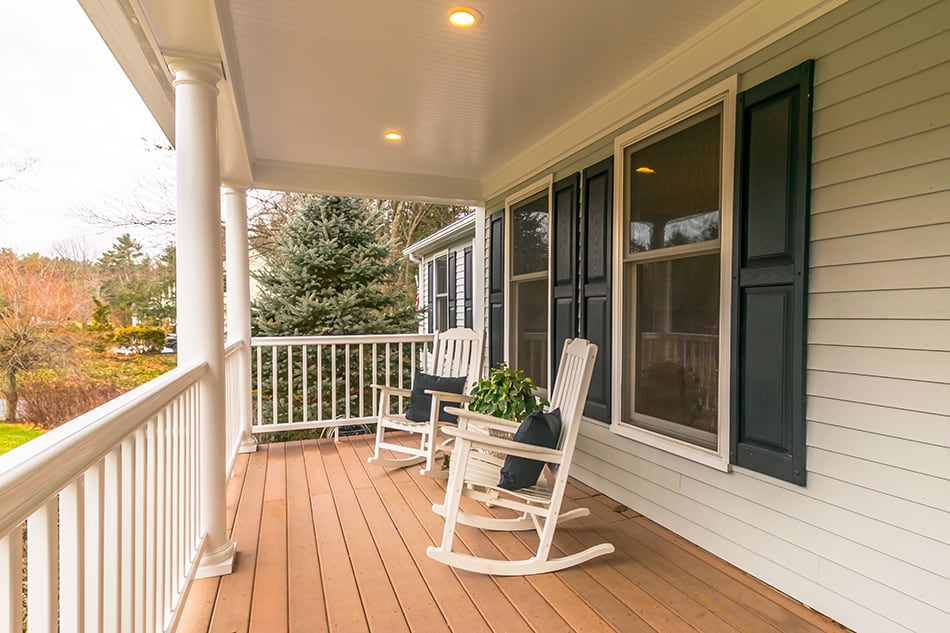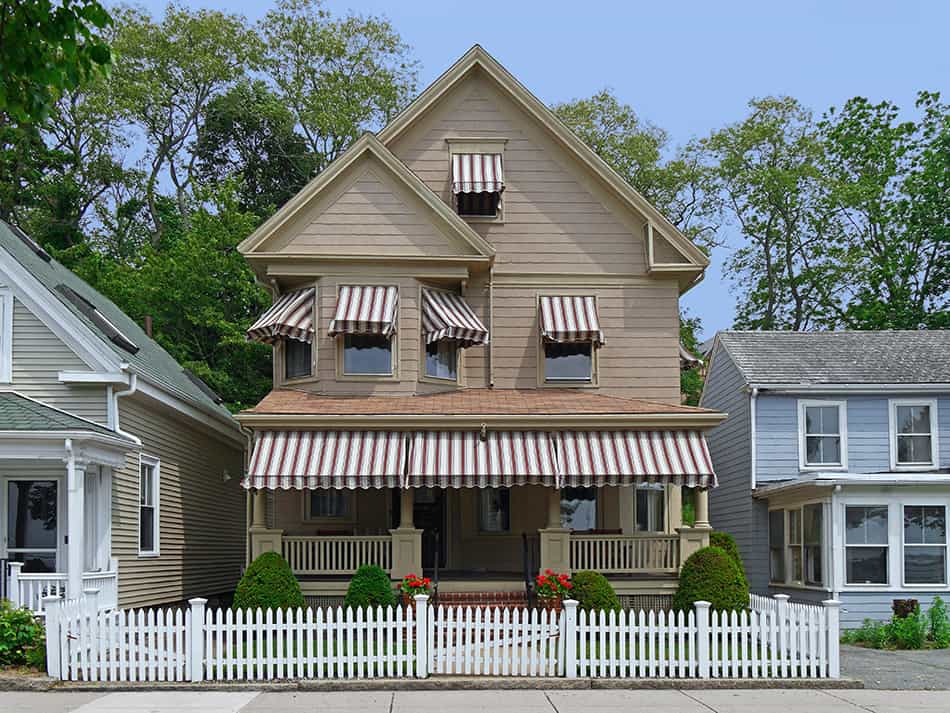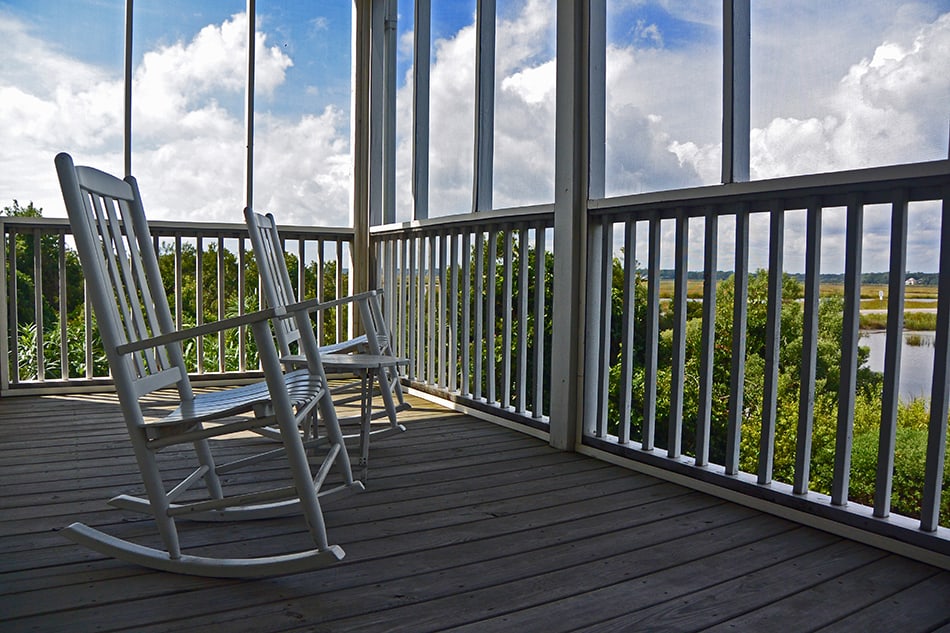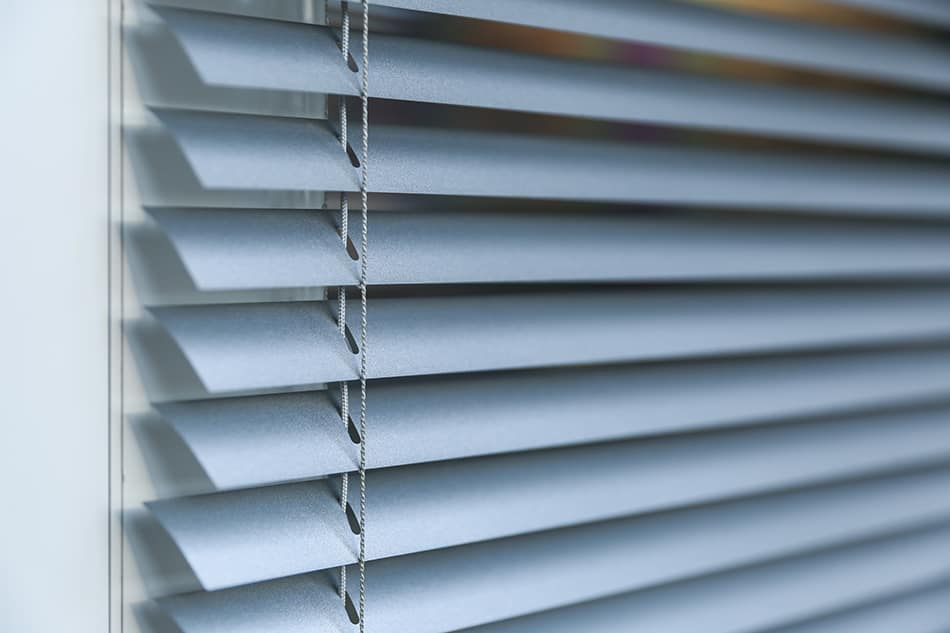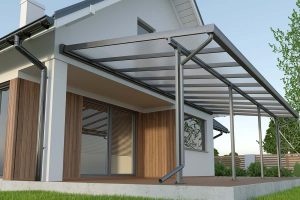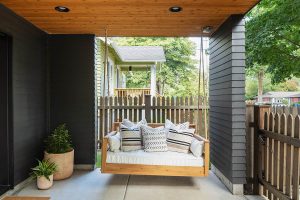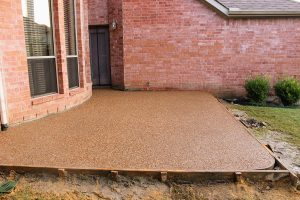Your porch can be a place for relaxation but also a source of constant worry if it is not protected from rain blowing in. Luckily for you, there are other ways to protect your furnishing besides moving it inside the house every time it is about to rain.
We have taken a look at some of the best solutions to keep rain from blowing in on the porch. Here is a list of our favorites and what makes them great.
Installing Awnings
For the rain to enter the porch, it has to be blown in by the wind at an angle that allows it to bypass your roof. The first logical solution that comes to mind is to simply extend your roof in a way. Awnings offer this exact solution at a fairly low price compared to other protective methods.
You can choose between two main types of awnings, the overhang and retractable. An overhang awning will usually require supports to be installed. It will not completely prevent rain from entering if strong winds are driving the rain in, but it will stop most rain from nearing your porch.
The retractable awnings have the benefit of being fully retractable on sunny days. They are usually extended either by a hand crank or an electric switch. The added perk of an awning is that it can also increase the size of your porch and provide that comforting shade.
Lean-to Roof
Lean-to roof is a style of roof mainly used for sheds, but it is nowadays becoming a popular solution for porches, greenhouses, and other subsidiary structures. Simply put, it is a roof that has one slope, making it easy for water and even snow to effortlessly run off.
The upper edge of the lean-to roof can be attached to the wall of your house and provide shade as well as cover from the rain for your porch area. The installation is easy and affordable, making it a very cost-effective solution.
Perhaps the biggest downside when choosing a lean-to roof is that you cannot remove it like an awning; it becomes a permanent structural addition to your home. If this is not a problem for you, a lean-to roof is worth considering if you are looking for a more spacious solution with versatile protection that will serve you well on both summer and winter days.
Materials used for lean-to roofs range from concrete to plastic. If you are looking for a lightweight material resistant to the impact of branches falling from nearby trees and such, consider opting for polycarbonate sheets. The added benefit of these sheets is that they are generally easy to install and require very basic fixing procedures, making them great for DIY enthusiasts.
Screening in the Porch
Screens can be effective albeit a bit more costly protection if you consider the materials required as well as potentially needing professional help to install everything properly. They come with the added benefit of preventing bugs and pesky mosquitoes from entering your porch.
One of the biggest decisions you will have to make is going to be the size of the screen panels. The smaller ones are a prudent choice if you have children or pets that might bump against the bottom panels. They are also simpler and cheaper to repair.
The larger panels are going to be more expensive and harder to repair. They are also more likely to bulge if exposed to constant winds or the aforementioned daredevils of your household. It is worth noting, though, that the larger panels provide that nice, less-obstructed view.
Lastly, keep in mind that screens have holes in them that could let some water enter your porch, but you can work around this problem by sloping the floor so that the water can trickle away.
Storm Windows
Storm windows are the best and most expensive solution. They can be seasonal or permanent and made of glass or fiberglass types. Guaranteed to last long, storm windows will offer unrivaled protection against not just rain blowing in but all elements.
The removable storm windows are quick to install or remove, making them an excellent choice if you wish to replace them with screens depending on the weather conditions and/or season. They will prevent rain from blowing in but also protect against wind damage.
The permanent storm windows will change the feel of the porch closer to that of a room, which is why some people steer away from them. What makes permanent windows worth the aesthetic trade-off is that they will keep any harsh weather conditions outside, allowing you to use the porch even when the weather gets colder.
If you decide to go with the permanent storm windows, you will want to keep an eye on the possible condensation problems. If left unattended, condensation on the windows can lead to mold growth. The easiest solution is to add vent holes for proper ventilation as well making the storm windows a tight fit. To improve air circulation on your porch, you can also open the windows when the weather is fine.
Plastic Sheets
A much more affordable solution to rainy days is plastic sheets or tarps. They can be simply cut to fit over your already installed screens and offer a great, temporary way to keep the rain away. The main downside of plastic sheets is that they are commonly not exactly aesthetically pleasing.
As one of the easiest DIY solutions, plastic sheets simply require you to measure the height of your screen porch openings and buy enough material so that you can cover it in its entirety. The plastic sheet should be a bit wider and longer than the area you plan to cover it with. Once the measurements are done, cut the plastic and staple it in place, starting from the top corners.
Another form of a plastic sheet perfect for your porch would be clear acrylic, also known as plexiglass. Admitting up to 92% of the sunlight, it is optically clearer than your standard glass window. Besides its transparency, a clear acrylic plastic sheet is also very resistant to weather, giving it significant longevity for outdoor use.
Weather Curtains
Another interesting option is weather curtains. They are generally not too expensive and easy to install. The curtains won’t offer complete protection from water and wind, but they are quite effective. They are most notably made from vinyl, waterproof fabric, or a combination of both.
Perhaps the greatest perk of weather curtains is that your porch will retain its spacious feel without being as vulnerable to different weather conditions. The curtains will provide shade as well as protection from wind. In case you expect strong winds, you can always reinforce the stability of the curtains in some way, depending on the material you’ve chosen.
The weather curtains are usually installed with the help of a curtain rod they are hung from, and Here’s how they work. The curtains are hung on a curtain rod and are tied with decorative knobs and grommets. They are easy to put up or take down, offering an attractive way to impact the way your porch looks as well as how protected it is from the rain.
Jalousie Windows
Not to be overlooked, there is another windowed solution to rain, the jalousie window. Though not as popular as in the 1950s when they were considered the cutting-edge technology, jalousie windows are still used for houses and porches alike. These windows have a unique design with horizontal slates angled so that they protect against rain and wind while allowing fresh air and sunlight in.
Jalousie windows can be a smart choice because they are adjustable. You can close the slates tightly during heavy rains but also adjust the angle to get a better view on sunny days. They are usually made of wood, glass, aluminum, or metal.
It is generally recommended to install jalousie windows in areas with a mild climate, but they can be used for porches even in the cooler areas. Even though they might require more cleaning if you wish to preserve the ease of opening and closing them shut, the improved air circulation they provide makes them an attractive option, especially for the areas close to nature and other sources of refreshing air.
Floor Slope
In most cases, you will want to pay attention to one more detail when protecting your porch against water damage, and that is floor slope. A properly sloped floor won’t prevent the rain from blowing in, but it will reduce the potential damage by draining water away.
You can accomplish proper water drainage in two ways. You can have a slight peak in the center area of the floor so that the water drains out the edges of your porch. Alternatively, you can slope the floor towards the center, where you will install a floor drain.
